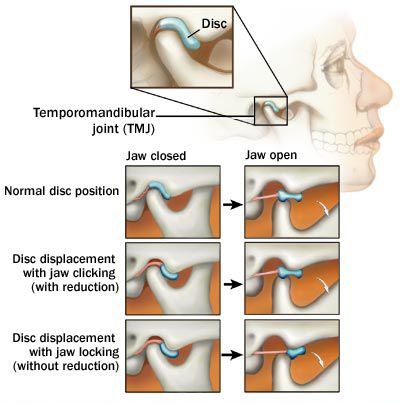 |
| Temporomandibular joint syndrome |
Temporomandibular joint syndrome (TMJ) is the name given to a group of symptoms that cause pain in the head, face, and jaw. The symptoms include headaches, soreness in the chewing muscles, and clicking or stiffness of the joints.
TMJ syndrome, which is also sometimes called TMJ disorder, results from pressure on the facial nerves due to muscle tension or abnormalities of the bones in the area of the hinge joint between the lower jaw and the temporal bone.
This hinge joint is called the temporomandibular joint. There are two temporomandibular joints, one on each side of the skull just in front of the ear. The temporal bone is the name of the section of the skull bones where the jawbone (the mandible) is connected.
  |
The jawbone is held in place by a combination of ligaments, tendons, and muscles. The temporomandibular joint also contains a piece of cartilage called a disc, which keeps the temporal bone and the jawbone from rubbing against each other. The jaw pivots at the joint area in front of the ear.
The pivoting motion of the jaw is complicated because it can move downward and from side to side as well as forward. Anything that causes a change in shape or functioning of the temporomandibular joint will cause pain and other symptoms.
Causes and symptoms
TMJ syndrome has several possible physical causes:
- Muscle tension. Muscle tightness in the temporomandibular joint usually results from overuse of muscles. This overuse in turn is often associated with psychological stress and clenching or grinding of the teeth (bruxism).
- Injury. A direct blow to the jaw or the side of the head can result in bone fracture, soft tissue bruising, or a dislocation of the temporomandibular joint itself.
- Arthritis. Both osteoarthritis and rheumatoid arthritis can cause TMJ.
- Internal derangement. Internal derangement is a condition in which the cartilage disk lies in front of its proper position. In most cases of internal derangement, the disc moves in and out of its correct location, making a clicking or popping noise as it moves. In a few cases, the disc is permanently out of position, and the patient’s range of motion in the jaw is limited.
- Hypermobility. Hypermobility is a condition in which the ligaments that hold the jaw in place are too loose and the jaw tends to slip out of its socket.
- Birth abnormalities. These are the least frequent causes of TMJ but do occur in a minority of patients. In some cases, the top of the jawbone is too small; in others, the top of the jawbone outgrows the lower part.
- Oral habits. Some dentists think that such habits as wide yawning, lip or tongue biting, or mouth breathing can contribute to TMJ by putting the jaw in an abnorml position for long periods of time.
- Dental work. Some people develop TMJ following dental work that requires the dentist to hold the patient’s jaw open wide for extended periods of time. Other patients develop TMJ following removal of the wisdom teeth.
People who are already suffering from depression or an anxiety disorder, people who have little social support in their lives, and people who feel that they have little control over their lives are at greater risk of developing chronic pain syndromes, including TMJ.
In many cases TMJ results from a combination of psychological, anatomical, and functional factors rather than a single abnormality.
The symptoms of TMJ depend in part on its cause or causes. The most common symptoms are facial pain in front of the ears; headaches; sore jaw muscles; a clicking sound when chewing; a grating sensation when opening and closing the mouth; and temporary locking of the jaw.
   |
Some patients also report a sensation of buzzing or ringing in the ears. Usually, the temporomandibular joint it-self is not painful. Most cases of TMJ are seen in women between 20–50 years of age.
Diagnosis
TMJ syndrome is most frequently diagnosed by dentists. The dentist can often diagnose TMJ based on physical examination of the patient’s face and jaw. The examination might include pressing on (palpating) the jaw muscles for soreness or asking the patient to open and close the jaw in order to check for misalignment of the teeth in the upper and lower jaw.
This condition is called malocclusion. The dentist might also gently move the patient’s jaw in order to check for loose ligaments.
Imaging studies are not usually necessary to diagnose TMJ. In most cases, x rays and MRI scans of the temporomandibular joint will be normal. Consequently, these two tests are not commonly used to diagnose TMJ. If the dentist suspects that the patient has internal derangement of the disc, a technique called arthrography can be used to make the diagnosis.
 |
| Temporomandibular joint disfunction |
In an arthrogram, a special dye is injected into the joint, which is then x-rayed. Arthrography can be used to evaluate the movement of the jaw and the disc as well as size and shape, and to evaluate the effectiveness of treatment for TMJ.
Another aid to diagnosing TMJ is a new questionnaire designed to discriminate between facial pain related to TMJ and myogenic facial pain, a chronic condition that is caused by trigger points in the muscles of the face and neck.
The McGill Pain Questionnaire has been reported to have a high degree of reliability in distinguishing between patients with TMJ and patients with myogenic facial pain.
Treatment
In many cases, the cause of pain in the TMJ area is temporary and disappears without treatment. About 80% of patients with TMJ will improve in six months without medications or physical treatments.
Biofeedback, which teaches an individual to control muscle tension and any associated pain through thought and visualization techniques, is also a treatment option for TMJ.
In biofeedback treatments, sensors placed on the surface of the jaw are connected to a special machine that allows the patient and healthcare professional to monitor a visual and/or audible readout of the level of tension in the jaw muscles.
Through relaxation and visualization exercises, the patient learns to relieve the tension and can actually see or hear the results of his or her efforts instantly through the sensor readout on the biofeedback equipment.
Once the technique is learned and the patient is able to recognize and differentiate between the feelings of muscle tension and muscle relaxation, the electromyographic biofeedback equipment it-self is no longer needed and the patient has a powerful, portable, and self-administered treatment tool to deal with pain and tension.
Stress management and relaxation techniques may be useful in breaking the habit of jaw clenching and teeth grinding. Tight jaw muscles are often relaxed by applying warm compresses to the sides of the face.
Acupuncture may relieve the jaw tension associated with TMJ. Massage therapy and deep tissue realignment can also assist in releasing the clenching pattern. Extra calcium and magnesium can also help relax jaw muscles.
Allopathic treatment
Allopathic practitioners are increasingly recommending more conservative treatments for TMJ, on the grounds that the majority of patients can be successfully treated with noninvasive, reversible approaches. These include patient education and eating softer foods as well as medication and the use of bite plates.
Patients with TMJ can be given muscle relaxants if their symptoms are related to muscle tension. Some patients may be given aspirin or nonsteroidal anti-inflammatory drugs (NSAIDs) for minor discomfort.
If the TMJ is related to rheumatoid arthritis, it may be treated with corticosteroids, methotrexate (MTX, Rheumatrex) or gold sodium (Myochrysine).
Patients who have difficulty with bruxism may be treated with splints. A plastic splint called a nightguard is given to the patient to place over the teeth before going to bed.
Splints can also be used to treat some cases of internal derangement by holding the jaw forward and keeping the disc in place until the ligaments tighten. The splint is adjusted over a period of two to four months.
TMJ can also also be treated with ultrasound, stretching exercises, transcutaneous electrical nerve stimulation (TENS), stress management techniques, or friction massage.
A 2002 study done at the University of Maryland found that all of these treatments are helpful to patients with TMJ, but none appears to be clearly superior to the others.
Surgery is ordinarily used only to treat TMJ caused by birth deformities or certain forms of internal derangement caused by misshapen discs.
Expected results
The prognosis for recovery from TMJ is excellent for almost all patients. Most patients do not need any form of long-term treatment. Surgical procedures to treat TMJ are quite successful.
In the case of patients with TMJ caused by arthritis or infectious diseases, the progression of the arthritis or the success of eliminating infectious agents determines whether TMJ can be eliminated.
